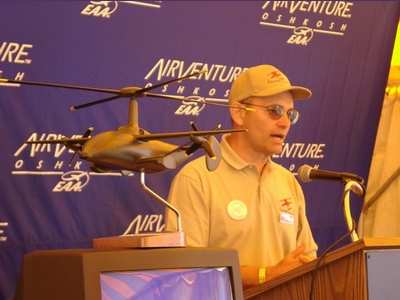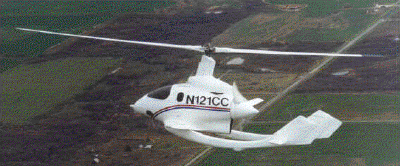Public Flights Scheduled for Friday and Saturday
One of the most-unusual and most-remarkable flying machines so
far devised, Jay Carter's Carter Copter, flew in to Airventure 2002
from Fond du Lac (WI), on Sunday. That flight was the first time
the public has been able to see the strange, competent machine.

As Carter's test pilot, Larry Neal, said yesterday, "It's the
most-exciting thing I've seen in my 51 years of being on this
planet." Larry was originally taken by gyroplanes as a teen, and
found a disused Bensen Gyrocopter, bought it, and trained himself
to fly it in three weeks, when he was 22. He's been hooked ever
since, and the Carter Copter is the ultimate gyro, what Jay Carter
calls a "heli-plane."
Brad King, after 30 years at GM, is now the test copilot. He
said that, after joining the small Carter Copters team, he "never
once felt like an outsider. It's great to be on a team, where
everybody's pushing in the same direction, and to do things
nobody's ever had a chance to do."
Mu1+
 Jay Carter says his first goal is to break the Mu1
barrier, well-known to rotorcraft folks, but unheard-of by
'civilians.' He explained that the Mu1 barrier will be reached when
the rearward-moving rotor blade is at zero airspeed. Since the
forward-moving rotor and the rearward-moving rotor both need to
produce equal lift, you can imagine the problem that's posed.
Jay Carter says his first goal is to break the Mu1
barrier, well-known to rotorcraft folks, but unheard-of by
'civilians.' He explained that the Mu1 barrier will be reached when
the rearward-moving rotor blade is at zero airspeed. Since the
forward-moving rotor and the rearward-moving rotor both need to
produce equal lift, you can imagine the problem that's posed.
Jay says the real problem comes in closer to Mu.75; and his
machine has already gone Mu.87. With more power, more streamlining,
and maybe a "LoPresti" treatment (wherein the machine's drag is
reduced), the Carter Copter design could go a lot faster. Jay sees
a jet-powered rotorcraft that would go maybe 500 mph.
Not a totally new idea; just a totally-new machine
 Mr Carter says that some 40 years ago, a lot of
helicopter manufacturers got close to breaking the Mu1 barrier, but
just got discouraged and quit. In fact, as Mu.5 is passed, some
rotorcraft, controlled with a traditional cyclic, will suddenly
require crossed control inputs. That little bit of knowledge goes a
long way toward explaining why earlier research may have been
abandoned. Even so, Jay thinks, "If helicopter manufacturers hadn't
given up fifty years ago, they probably would have done it." Well,
they did; and so they didn't. Carter didn't, and so he
will.
Mr Carter says that some 40 years ago, a lot of
helicopter manufacturers got close to breaking the Mu1 barrier, but
just got discouraged and quit. In fact, as Mu.5 is passed, some
rotorcraft, controlled with a traditional cyclic, will suddenly
require crossed control inputs. That little bit of knowledge goes a
long way toward explaining why earlier research may have been
abandoned. Even so, Jay thinks, "If helicopter manufacturers hadn't
given up fifty years ago, they probably would have done it." Well,
they did; and so they didn't. Carter didn't, and so he
will.
Carter's flying machine sports very low rotor speeds. At 172
mph, the rotor is turning just 115 rpm. That keeps the other
problem -- the advancing blade's tips from going past about .85
Mach -- from happening.
However, at 115 rpm, the rotor isn't generating appreciable
lift. That is the key to Carter's puzzle: the Carter Copter has a
fixed wing, too. When the rotor gets slowed down, the wing can take
over, for the lift function. At low airspeeds, the rotor does the
lifting; at high speeds, the rotor essentially gets out of the way,
and lets the wing do the job.
There's another advantage: because the fixed wing doesn't really
start earning its keep until maybe 150 mph, it can be designed to
work well at those high speeds, and not have to provide the lift at
low speeds. Smaller wing area, faster airfoil: lift when you need
it, and lower drag. Oh -- as the machine gains speed beyond Mu.75,
the rotor can again be used for lift. It's that nasty transition,
where things get temporarily out of balance with each other.
For most of the Carter Copter's development, the pilots
controlled everything; now, with some data becoming available in
verifiable form, Carter can program electronic systems to take over
some functions, easing the pilots' load, and allowing them to do
more development.
The hard part (above) was 'how.' So, 'why?'

Carter sees that the machine will become increasingly useful,
not just because of the inevitable loss of airports in the future
(which makes vertical capability more a factor), but also
because the concept is scalable, up to and including a machine that
could carry more than a C-130 -- and faster. The design, he claims,
is also inherently more fuel-efficient than today's airplanes, or
helicopters.
OK -- when?
 There's too much more to do, to put dates on such
things as kit availability, or licensing to firms that might make
commercially-available Carter-designed heli-planes. If development
continues to go well, if money comes in on schedule, if... well,
Carter thinks it'll be ten years from now, when "...grandma and
grampa will think no more of getting into a machine like this and
going 400 miles to see their grandkids, than they do now, crossing
town." Oh -- and there won't be a human pilot. UAV research will
make it possible. He says it, and it's somehow believeable.
"Remember," he said, "it wasn't too long ago that people wouldn't
ride in an elevator, unless it had an operator sitting in it.
There's too much more to do, to put dates on such
things as kit availability, or licensing to firms that might make
commercially-available Carter-designed heli-planes. If development
continues to go well, if money comes in on schedule, if... well,
Carter thinks it'll be ten years from now, when "...grandma and
grampa will think no more of getting into a machine like this and
going 400 miles to see their grandkids, than they do now, crossing
town." Oh -- and there won't be a human pilot. UAV research will
make it possible. He says it, and it's somehow believeable.
"Remember," he said, "it wasn't too long ago that people wouldn't
ride in an elevator, unless it had an operator sitting in it.
 ANN's Daily Aero-Term (05.12.25): Execute Missed Approach
ANN's Daily Aero-Term (05.12.25): Execute Missed Approach ANN's Daily Aero-Linx (05.12.25)
ANN's Daily Aero-Linx (05.12.25) NTSB Final Report: Piper PA-36-375
NTSB Final Report: Piper PA-36-375 Airborne-NextGen 05.06.25: AF Uncrewed Fighters, Drones v Planes, Joby Crew Test
Airborne-NextGen 05.06.25: AF Uncrewed Fighters, Drones v Planes, Joby Crew Test ANN's Daily Aero-Linx (05.13.25)
ANN's Daily Aero-Linx (05.13.25)







